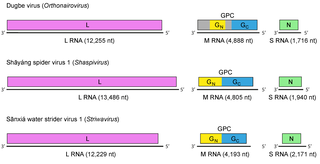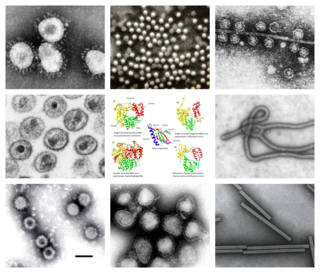Virus classification is the process of naming viruses and placing them into a taxonomic system similar to the classification systems used for cellular organisms.

Bunyavirales is an order of segmented negative-strand RNA viruses with mainly tripartite genomes. Member viruses infect arthropods, plants, protozoans, and vertebrates. It is the only order in the class Ellioviricetes. The name Bunyavirales derives from Bunyamwera, where the original type species Bunyamwera orthobunyavirus was first discovered. Ellioviricetes is named in honor of late virologist Richard M. Elliott for his early work on bunyaviruses.
Luteoviridae was a family of viruses. The family was abolished in 2020 based on evidence that its three genera and seven species unassigned to a genus belonged to two other, existing families.

Orthonairovirus is a genus of viruses in the family Nairoviridae of the order Bunyavirales that include viruses with circular, negative-sense single stranded RNA. It got its name from the Nairobi sheep disease that affects the gastrointestinal tracts of sheep and goats. The vast majority, and perhaps all viruses in this genus are tick-borne viruses that can have human or other vertebrate hosts.
Kupe orthonairovirus, also called Kupe virus, is a species of virus in the genus Orthonairovirus.
Abu Hammad orthonairovirus, also called Abu Hammad virus (AHV), is a species of virus in the genus Orthonairovirus. It was isolated from a tick, Argas hermanni, in Egypt. This virus doesn't cause disease in humans.
Abu Mina orthonairovirus, also called Abu Mina virus (ABMV), is a species of virus in the genus Orthonairovirus. This virus has not been reported to cause disease in humans.
In 1954 the Hazara orthonairovirus, one of the 34 tick-borne viruses of the genus Orthonairovirus, was discovered in Pakistan in the Ixodes tick native to that region. Today this virus is studied in mice in an attempt to develop treatments for the highly pathogenic Crimean-Congo Hemorrhagic Fever virus.

Nairoviridae is a family of viruses in the order Bunyavirales. Its name derives from Nairobi sheep disease, caused by the member Nairobi sheep disease orthonairovirus.
Kasokero orthonairovirus is a species of virus in the genus Orthonairovirus. Its only known host is the fruit bat Rousettus aegyptiacus. The virus takes its name from the Kasokero Cave in Uganda, where it was first collected.
The Nairobi sheep disease orthonairovirus (NSDV), also known as Ganjam virus is a species in the genus Orthonairovirus belonging to the Nairobi sheep disease serogroup. NSDV's known hosts belong to the hard tick family Ixodidae, including Rhipicephalus appendiculatus, and Amblyomma variegatum, and afflict sheep and goats naturally. The virus is in the family Nairoviridae and order Bunyavirales.
Puffin Island virus, is a strain of Dugbe orthonairovirus belonging to the Hughes serogroup.
Artashat orthonairovirus, also called Artashat virus (ARTSV), is a species in the genus Orthonairovirus. It was first isolated in Armenia in 1972 from Ornithodoros alactagalis, a soft tick of the family Argasidae.

Riboviria is a realm of viruses that includes all viruses that use a homologous RNA-dependent polymerase for replication. It includes RNA viruses that encode an RNA-dependent RNA polymerase, as well as reverse-transcribing viruses that encode an RNA-dependent DNA polymerase. RNA-dependent RNA polymerase (RdRp), also called RNA replicase, produces RNA from RNA. RNA-dependent DNA polymerase (RdDp), also called reverse transcriptase (RT), produces DNA from RNA. These enzymes are essential for replicating the viral genome and transcribing viral genes into messenger RNA (mRNA) for translation of viral proteins.
The Tofla virus is a strain of Hazara orthonairovirus in the genus Orthonairovirus belonging to the Crimean-Congo hemorrhagic fever serogroup. It was isolated from Ixodid in Japan in 2016.
Farallon virus is a strain of Hughes orthonairovirus in the genus Orthonairovirus belonging to the Hughes serogroup. A known host of the virus is Ornithodoros. The virus is named after the Farallon Islands.
Arfiviricetes is a class of viruses.

Orthornavirae is a kingdom of viruses that have genomes made of ribonucleic acid (RNA), those genomes encoding an RNA-dependent RNA polymerase (RdRp). The RdRp is used to transcribe the viral RNA genome into messenger RNA (mRNA) and to replicate the genome. Viruses in this kingdom also share a number of characteristics involving evolution, including high rates of genetic mutations, recombinations, and reassortments.
Durnavirales is an order of double-stranded RNA viruses which infect eukaryotes. The name of the group derives from Italian duplo which means double, rna for the type of virus, and -virales which is the suffix for a virus order.

Adnaviria is a realm of viruses that includes archaeal viruses that have a filamentous virion and a linear, double-stranded DNA genome. The genome exists in A-form (A-DNA) and encodes a dimeric major capsid protein (MCP) that contains the SIRV2 fold, a type of alpha-helix bundle containing four helices. The virion consists of the genome encased in capsid proteins to form a helical nucleoprotein complex. For some viruses, this helix is surrounded by a lipid membrane called an envelope. Some contain an additional protein layer between the nucleoprotein helix and the envelope. Complete virions are long and thin and may be flexible or a stiff like a rod.





